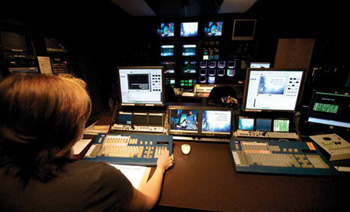Streaming and Broadcast Options for HOWs of All Sizes
Lake Pointe Church has a live production control room that deploys Chyron graphics, and it is used at least once a week and generally more often. The system includes three screens utilized during a service, center and sides, and can drive each screen independently.
The messages they want to deliver are clarion clear. Choosing the type of messenger is a little more complex.
As more houses of worship move into broadcast production, adding technology for everything from acquisition to editing, opportunities abound in smaller congregations, too.
Trends in the HOW market largely mirror those in all digital media, noted John Paul Cardoso, eastern and Caribbean sales manager for Broadcast Pix. “As tools become increasingly accessible, with far more tools at lower costs, this translates into better feasibility in bringing in digital media for many types of customers whether corporate or HOW . When that happens, you look to standard bearers for what you want to emulate.”
We live in a “wannabe” industry, he said, where the larger churches possess influence and the smaller ones want to be at that same level of technology, although that does not always mean that they’re looking at the same tools; a 10,000-seat facility may have a substantial budget.
There is a trickle-down effect from larger HOW s to smaller venues, acknowledged Rob Sheeley, president of Vaddio. “Typically, the mega churches are first on the block to adopt technology due to their advanced production requirements, and, if you look at the evolutionary process, it started with cassettes and moved to DVDs until someone realized their program could be streamed on the web. As a result, streaming has created a whole new way of delivering their message to the congregation. Now every HOW has a chance to create their own network.”
And with the HOW market expanding, smaller churches are looking to grow, said Tedd Tramaloni, product specialist with Snell. “Midsize HOW s are adding to their congregations, and as a result, they’re finding that they have to compete with other forms of diversion. Saturday night and Sunday services are thought of as ways for families to be together, but must still compete with other ‘entertainment’ options.”
There is also a noticeable geographical aspect to the HOW market. “Taking a look at the upcoming Metro Media Ministers Association conference to be held in mid-July at Lake Pointe Church, (Rockwall, TX), I am surprised by the geographical diversity,” observed Gene Sudduth, senior account executive, Chyron. “There are members from the East Coast to central and northern Midwest U.S. It says that the community is even larger and more connected than one might have guessed. Most members represent fairly large churches with at least 2,000 members. The larger ones are doing what amounts to a weekly closed broadcast and their production value requirements are every bit as demanding as a broadcaster’s might be.”
Sudduth noted that Lake Pointe, for example, has a live production control room used at least once a week and generally more often. The system includes three screens utilized during a service, center and sides, and can drive each screen independently.
“As a long-standing customer, Lake Pointe has used Chyron’s LEX for years and is getting ready for an HD transition in the months ahead with Chyron’s new LEX 3.1,” he said. “A larger church in Dallas, which used a competitor’s product for five years, recently decided to move its platforms to Chyron after visiting Lake Pointe. It’s a good place of reference for us.”
Cardoso said a large percentage of his customers are HOW s with a major concentrations in the Southeast, and in central and western states, too. “But that’s changing,” he indicated. “Churches in the northeast have traditionally remained less technically-inclined. But with the trend in urban areas toward evangelical congregations using video and social media, the Northeast churches are moving more toward it as well, especially in their urban centers where they serve immigrant and diverse populations. Even more traditional churches are offering contemporary services with greater use of electronic media.”
Ministries such as that of televangelist Joel Osteen have had a remarkable influence on what HOW s request when going that route. “I can’t even tell you how many customers have mentioned Osteen Ministries and said they want what he uses,” he said.
The Basics
The fundamentals of electronic communication, support of a service via video outreach and routing to secondary rooms, was the first footprint, Cardoso explained. “There’s a second side, more evangelical outreach, that is where printing to DVDs, streaming, and progressive downloads come in along with social media. This emanates from a media/control center and the center needs to manage social media and streaming and to route sources to multiple places and broadcast-type controls. We found that traditional switcher layouts are still the most effective way of controlling a video stream; it allows users to view the action versus an interface.”
Recent changes could spell growth for Wohler Technologies, which currently has a fairly small HOW customer base, noted Jeff McNall, of the manufacturer’s direct product line management, audio, and video, “Everyone is heading toward a digital infrastructure, and this means people can move things around. Once, it was about TV stations; churches all were analog. Now, everything is blended together.”
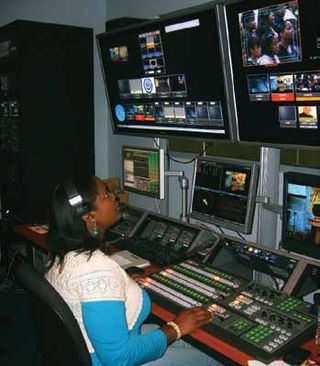
A new Broadcast Pix Slate 5000 is helping Abundant Life Family Worship Church produce high-quality video productions for public access and live streaming audiences.
McNall said products Wohler develops for the greater broadcast market can also be applied to the HOW market. “Our Presto Video Switcher and MADI-8 are perfect examples of this,” he elaborated. “During large audience presentations in an HOW environment, the Presto provides preview selection for a given audio/video feed before taking it to the big screen. Our MADI-8 product allows audio operators to harness the 64-channel MADI stream capability provided in large audio mixing consoles.”
Traditionally, McNall said, HOW s face large cable runs to provide audio sends to various areas of a facility. “By being able to assign any of the 64 channels to any of the eight monitoring channels in the unit, they have a tailored mix of the desired audio channels. With 64 channels on a single wire in a daisy-chain configuration, they can reduce the bulky cable mess that lines the walls of their halls.”
Snell’s HOW clients are looking toward multiple systems because they have a variety of obligations, such as web streaming onto another campus, Tramaloni said. “A single switcher is not enough anymore; churches need multiple switchers and that’s why our Kahuna is so popular.”
The new Snell Kahuna 360 recently began shipping. “We anticipate that as the 360 becomes more visible, it will prove to be popular in the HOW market because of its expandability and flexibility,” he speculated. “This is a huge workflow advantage since the same program can easily be output in various formats to accommodate differing requirements, such as web, recording, cable access, etc.”
Kahuna’s ability to do internal format conversion across the entire input matrix means that fewer external converters and delay units are required, Tramaloni said. “In turn, this reduces the wiring, electrical, HVAC and space requirements. From an integrator’s perspective, the design is simpler, more economical, and expandable down the road. And because Kahuna 360 is 1080p compatible, if and when that becomes important in HOW production, which is an emerging issue, it will be easy to integrate via a simple software upgrade.”
At Chyron, the LEX and MicroX platforms are the most popular for HOW customers, Sudduth indicated. “One Dallas-area church with three campuses that has been using an alternative solution on its second campus, is now moving to a full broadcast environment, and will push content from its main location to the remote campus. Both facilities will be able to create and share content seamlessly. One church member there is a director of technology for a large, well-known broadcast group.”
Streaming varies depending on the level of sophistication, he said. “They can grow into it when there is enough demand and desire to reach out past their physical boundaries. One of my accounts is the privately held Daystar Television in the Dallas/Fort Worth area, one of largest religious programming networks in the world, steaming everything they do. They’re not a HOW as such; rather they are a religious broadcasting network with stations all over the country. The HOW market is clearly more than independent churches: the networks are every bit as important in this market segment as they are in traditional broadcast venues.
When Looks Count
HOW s need pre-produced videos with singers, testimonials, and graphic support, all routed into the central control surface. That’s a lot to manage, Cardoso said. “The harder question is how to avoid content that looks low-budget, with tangible stream quality but poor integration, or graphics that aren’t synchronized. Superior, tight integration is the best way to ensure quality.”
The solution is to take all of the file-based information, in addition to live information, onto a single control surface, as is found on Broadcast Pix Granite live production systems. “The tools are there, and the other main ingredient is the talent behind the board, the technical director,” he emphasized. “Having someone who sees the whole and understands how it all fits together is the lynchpin. It comes down to who’s running the tools.”
In many instances, a HOW might have members of their youth group who are already familiar with the latest desktop digital editing tools to create compelling content to be played back during services, noted Wohler’s McNall.
Keep the HOW volunteers in mind early in the design phase, advised Vaddio’s Sheeley. “We have a tendency to make things complex when simplicity is the key. A lot happens on a smart phone automatically; what we’ve been doing here is to automate camera controls so it has presets. We all like technology but nobody wants to use it.”
Integrators and consultants need to establish better production values, he said. “With HOW s, there are two main applications they use, remote ministry, which is the recording and or streaming of the service, and image magnification, which is all about local display in the church. But what they show on the projector isn’t necessarily what they want on the stream.”
It all comes down to the right tool sets and content creators, Sudduth emphasized. “Avoiding the look of a low-budget project for smaller churches hinges on it. There are a number of viable tool sets that can work. High-quality results most often come from content creators with artistic or broadcast backgrounds.”
Designing an HOW system is a consultative process with budgets dictating which tool sets are available for a given project. “More and more, we’re seeing system integrators who normally work in the traditional broadcast and/or sports arena markets working in the HOW environment,” he observed.
Karen Mitchell is a freelance writer based in Boulder, CO.
RGB Spectrum Linx Prime and F Series

RGB Spectrum has expanded the Linx family of matrix routing switchers: Linx Prime, which allows a mix and match of seven different I/O card/signal types plus scaling; and Linx F series, an all fiber switcher used in conjunction with RGB’s FiberDVI transmitters and receivers. Linx Prime is a multi-format switcher offering scaled outputs. The HDMI certified switchers offer full HDCP compliance over copper and fiber. The Linx F Series offers all the advantages of a switcher with advanced EDID management and HDCP compliance plus the ability to run over a single fiber up to 500 meters both in and out of the switch. Each modular card features two independent channels with SC connectors used in conjunction with FiberDVI transmit and receive units located at sources and displays.
Atlona AT-PRO2HD88M-SR and AT-PRO2HD1616M-SR

The Atlona AT-PRO2HD88M-SR and AT-PRO2HD1616M-SR are true 8x8 and 16x16 high-speed HDMI matrix switchers, featuring eight or 16 HDMI 1.4 inputs and eight or 16 independently switchable twisted pair outputs to feed eight or 16 separate receiver modules (included). The units have the ability to equalize, amplify, and reclock the signal to ensure HDMI-accurate signal transmission through long cables without quality loss. Featuring HDBaseT technology, the switchers extend HDMI sources up to 330 feet at 4000x2000 resolution over a single Cat-5/6/7 cable.
PESA OC44-3G-P4

PESA’S OC44-3G-P4 is a multirate, four input and four output high definition routing system with a full set of features for network control. Self-contained in a 1RU chassis, the OC44-3G-P4 offers full auto equalization at each input for cable lengths over 300 meters at 720p and 100 meters at 1080i or 1080p. Each output port can be configured for standard SMPTE re-clocking data rates or set for auto-bypass mode when non-SMPTE signals are required. This unit is capable of storing multiple switch presets and provides glitch-free switching with genlocked sources. Signal management control includes breakaway level switching and output signal locking.
MultiDyne EOS-5000
MultiDyne Video & Fiber Optic Systems’ EOS-5000 supports copper signals and fiber optic multimode and single-mode fiber feeds. The EOS-5000 supports data rates from 10 Mbps up to 10 Gbps. This will include 3G HDSDI video and all standard SDI video formats in the copper and optical domain. The EOS-5000 is available from 36x36 up to 144x144 in one chassis. By providing copper inputs and outputs, a local monitor can receive a copper input directly from the router. The optical output will no longer require a conversion from optical to copper. The EOS-5000 features a front panel programmable LCD display with setup menu and diagnostics along with automatic failover, and redundant controllers.
QVS HD4-44

The HD4-44 HDMI multi-function switch allows multiple and single display of HDMI sources simultaneously. Switch source device for each display by using remote control, manual push button, or with RS232. Optional IR adapter is perfect for home theater to control the source remotely. Any source to any display matrix switching allows versatility for integrated digital signage systems. The switcher features mounting wings and slim design for installation flexibility. It supports full HD HDMI 1.4a/HDCP, 3D, 1080p, deep color 36bit, Xv-YCC, DTS-HD, Dolby TrueHD multi-channel digital audio, LPCM7.1, DSD, Blu-ray player for 24fs film format, and 6.75Gbps data transfer speed.
Key Digital KD -HDMS8x8-13x3
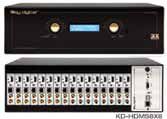
Key Digital Systems’ Hercules Series KD-HDMS8x8-13x3 matrix switcher is an advanced HDMI matrix switcher designed especially for board/conference room applications due to 16 flexible slots, which can be configured for any combination of 16. The KD-HDMS8x8-13x3 allows for easy programming, simple operation, and flexibility due to full audio control for each output including: volume, treble, bass, balance, and lip-sync. Further simplifying a board/conference room AV system installation is the KD-HDMS8x8- 13x3’s ability to be controlled by IP and connect between IP and RS-232 connections.
Crestron CENRGBHVHB8X8
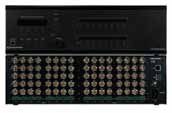
Crestron’s 8x8 high bandwidth RGB matrix switcher features ultra high-bandwidth 800 MHz matrix switching, built-in audio DSP, and automatic ducking. The CEN-RGBHVHB8X8 is capable of routing up to eight computer or video sources to up to eight display devices. Its five matrix levels accommodate any combination of analog RGBHV, HD/ component, S-video and composite signals. Sync impedances for each input are selectable from the front panel or software to accommodate both short and long cable runs. Featuring an informative LCD display, quick-adjust knob, and quick access buttons, the front panel supports essential switcher operation without requiring a computer or control system. Advanced setup is available through Crestron Toolbox software. All signal routing, input impedances, and audio settings are stored in non-volatile memory onboard the switcher.
Gefen 32x32 DVI Matrix

The GefenPRO 32x32 DVI Matrix offers cross-point switching among 32 computers and displays, with a one-to-one or one-to-many routing, controlled by front-panel button, RS-232, IR remote, or IP control. This matrix offers an open architecture that supports DVI and HDMI (with adapter) sources, outputting all video in the DVI format. It is a modular card cage system allowing different configurations of several inputs/outputs modules, with the added option to extend any number of outputs over CAT-5 or fiber optic cables. Though designed to supply AV and studio professionals with a solution for switching many different sources to many locations, it is also appropriate for digital signage, large presentations, and video walls that need immediate access to many computers.
Xantech VCS1080

Xantech’s 9-input presentation scaler/switcher accepts NTSC, PAL and SECAM standard video in composite, S-video or component video format, as well as JPEG inputs, via RCA, 15-pin HD, HDMI, and USB connectors. On the audio side, the VCS1080 handles unbalanced stereo and S/ PDIF audio signals. A key feature is that the HDMI and VGA outputs are active at the same time, allowing users to distribute video to a projector and a flat-screen panel simultaneously. The VCS1080 incorporates IDT HQV video processing to ensure high quality scaling for large audience presentation applications requiring conversion and switching of multiple formats of standard- and high-definition video as well as graphic data signals.
Hall Research HSM-I-04-04

The HSM-I-04-04 is a four-in and four-out matrix switch with RS232 and IP Control. The video switch can be controlled from anywhere using a PC, smart phone, or tablet while supporting multiple simultaneous users. The IP (LAN) port includes a built-in web server with web-based software to control the switch from any modern browser. The embedded HSM IP Manager software allows the user to assign custom names for each input, output, and preset pattern, making control over IP simple. It is HDMI 1.3 compliant, supports HDCP and HDMI 1.4 3D, deep color, multi-channel digital audio (up to 7.1 channels), and may be used with any combination of DVI (PC) or HDMI (HDTV) sources and displays.
Magenta Voyager VG-Matrix
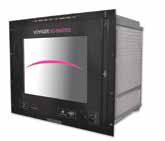
The VG-Matrix series fiber optic matrix switchers deliver a modular and scalable full crosspoint matrix switching platform that can be field configured in increments of eight inputs and/or outputs up to a maximum of 160x160. Fiber I/O cards connect seamlessly to the fiber inputs or outputs of Voyager transmitters and receivers delivering matrix switching and long distance extension in one platform. Switch sizes larger than 160x160 are available. Other features include uncompressed multi-format digital and analog video at 1920x1200, auto format conversion between video and audio signal types, mixed singlemode and multimode fiber support, advanced EDID management and full HDCP compliance, as well as dual redundant, hot swappable power supplies with dual AC inputs.
Extron XTP CrossPoint

The XTP CrossPoint system from Extron is a flexible, reliable signal switching and distribution system that provides an integrated solution for multiple digital and analog formats. XTP CrossPoint Systems support local connectivity, as well as extended transmission capability for sending high resolution video, audio, RS-232, ethernet, and power up to 330 feet over a single Cat-5-type cable. Other technologies incorporated into the XTP CrossPoint systems include SpeedSwitch technology, EDID Minder, and Key Minder for fast, reliable switching of HDMI and DVI signals and HDCP-encrypted content, SD Pro processing for de-interlacing standard definition signals to eliminate display compatibility issues, and automatic input cable equalization and output reclocking that provide digital video signal conditioning to ensure optimal performance.
Kramer VP-747 In-CTRL

Kramer Electronics has introduced the VP-747 In-CTRL dual scaler seamless switcher with eight sets of universal inputs. The universal inputs are comprised of five BNC connectors each, two of which can also be used as HDMI/ DVI inputs on DVI connectors. A key feature of the VP-747 is the incorporation of HQV processing technology for image quality, which represents the state-of-the-art in video processing technology. It offers the highest quality de-interlacing (with 3:2 and 2:2 pull down), advanced noise reduction that reduces block chroma and mosquito noise, and scaling performance for both standard and high-definition signals.
Get Thee to The Cloud
“What will be interesting,” said Ron Sheeley, Vaddio, “is that cloud streaming services will someday displace a lot of proprietary servers. If I go to the cloud, that becomes my broadcaster to everywhere. All I need to deliver from the church is a single stream. This will change the HOW market. For example, there’s a little church in Wisconsin that for $150 a month will be able to stream anywhere in the world to multiple clients due to a low-cost CDN.”
Because you can now stream anywhere in the world, to anyone in the world, and inexpensively, production values will go way up, Sheeley added. “The idea of really good broadcast transition, graphics, fades, wipes and dissolves, will become more important, as will camera automation and multicamera shoots. Now, HOW will have two, three, or four cameras mounted in different areas, and they can offer more interesting camera shots and as a result, give the viewer a higher quality production.”
The tools, technologies, and transport delivery mechanisms are already available for HOWs to stream and deliver any way they want. “Newer multi-platform streaming technologies, such as those offered by Wowza offer streaming server software packages that provide the ability to stream to any device,” Sheeley explained. “Bundle this with Amazon’s new CloudFront web service and any church can have access to Amazon’s global footprint of servers, and can stream anywhere in the world.”
—K.M.
